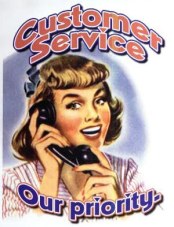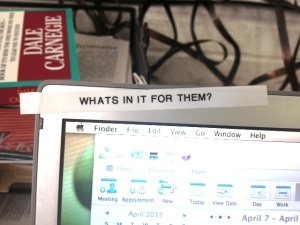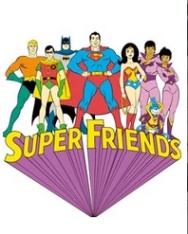While I once prided myself on my ability to multitask, I realize now that the “art” of multitasking is an exhilarating whirlwind (Nerd Alert: I actually love being busy – with work I enjoy, anyway) that can quickly sweep up and spit out its victims, leaving them stuck in a tree, jostled, fractured, staring down at a pile of debris and wondering where on Earth to start.
The fact is, in the communications industry, things happen very quickly. There are a lot of  projects going on at once, and, just because YOU plan to devote time to ONE project, it doesn’t mean the people you need to talk to about it will be available that time, or that you won’t get an urgent phone call that interrupts your whole day.
projects going on at once, and, just because YOU plan to devote time to ONE project, it doesn’t mean the people you need to talk to about it will be available that time, or that you won’t get an urgent phone call that interrupts your whole day.
**I’d also like to point out that a lot of us marketing/advertising/writing folks are creative thinkers, and often roll from one great idea to the next before we have time to write them down, and so they are lost and gone forever – or that spreadsheet you were working on when you abandoned it to develop your big, awesome idea – is forgotten about and neglected until you accidentally stumble upon it in your project folder six months later…whoops! Some people call it ADD. I call it super-thinking.**
My point is, I’ve learned that it is crucial to have a strong organization system so that you don’t let things fall between the cracks in your day, week, month, and year. So when your boss (or your client, depending on your work situation) asks you about what time the trade show three months from now starts or when the newsletter is supposed to go out or what the status of a report is, you can answer quickly and definitely, rather than sitting there with the deer-in-headlights stare, filing through all the volumes of information you keep in your head, jumbling the facts, getting frustrated, and appearing unprofessional.
Here are a few unconventional and traditional that I use to stay on top of things:
1. Get a synchronized mobile calendar – and USE it. Most professionals I know have smartphones and computers that use iCal or Gmail or Outlook calendars – which automatically sync up together when you add a new event – but seldom actually take advantage of these features. When you schedule a meeting with someone, put it on your calendar. Invite anyone else who needs to know about it. When you schedule a doctor’s appointment, instead of just taking an appointment reminder card, add it to your mobile calendar. It’s all done with the click of a button, and it’s so easy. Just do it. It will save you tons of worry, headaches, and missed appointments down the line.
2. Print out a six month calendar. Sometimes it’s just easier to see things from a broader perspective. In addition to keeping a tight digital calendar, I keep a six month calendar of only big events, such as our trade show dates, awards entry dates and other important deadlines. I downloaded a blank calendar from the Internet and printed it in landscape mode on legal size paper. That maximizes my viewing so I can now see that two of our biggest events are just four small weeks away, and I don’t get blindsided by big events I’d forgotten about.
3. Use a physical filing system. I prefer a tiered wire manila folder holder so I can see all by big project folders at once, and I have 3-ring binders for those big, hairy projects with lots of sections and subfolders. Everything is within quick reach and organized alphabeticaly for easy access. **This came in particularly handy one night when my boss texted me, urgently asking where he could find the RFP we had received a few days earlier via fax. I did not get his message, so that might have created a small crisis for him – but luckily, by just walking over to my desk and looking at my file organizer, he quickly found the one labeled “RFPs” and found what he was looking for. Crisis averted.
4. Use a digital filing system. Outlook, gmail, and Apple mail all have decent systems for subfolders. I recommend using as many top-level subfolders as possible. No one wants to hunt through 50 subfolders to find where to put one email, but it’s easy to drag it over to one area and drop it. Also, creating and USING folders and subfolders within your computer’s document storage can help you easily find what you’re looking for, which helps when you’re crunched for time – which, let’s face it, is often the case in this industry.
5. Post it. Facebook consumes so much of our lives because it’s a constant stream of information. Often, on my newsfeed, I’ll see an update that reads something like “So-and-so read this article about such-and-such.” So I click on the article and decide I should read it too, but I don’t have time right now. So what do I do? I “share” the post with myself, via direct message or even on my wall under the “Only Me” privacy setting, and come back to it later.
6. Post-it post it. Although technology has taken us strides in information gathering and  management, nothing will ever be as effective for me as a good old-fashioned post-it note. Prioritizing my top 5 or 10 action items on a sticky note and slapping it to my desk puts the laundry list right in my face, every day, in person, and I cross off the items as I accomplish them. So that 15 minutes at the beginning of every work day wondering, “Where should I start?” is no longer necessary. It’s all written right there in front of you. And if you have an awesome, creative idea in the middle of another project, scribble it on a sticky, slap it to your computer monitor, and come back to it later. Twenty minutes later or 4 days later – it will still be there until you can follow up with that thought.
management, nothing will ever be as effective for me as a good old-fashioned post-it note. Prioritizing my top 5 or 10 action items on a sticky note and slapping it to my desk puts the laundry list right in my face, every day, in person, and I cross off the items as I accomplish them. So that 15 minutes at the beginning of every work day wondering, “Where should I start?” is no longer necessary. It’s all written right there in front of you. And if you have an awesome, creative idea in the middle of another project, scribble it on a sticky, slap it to your computer monitor, and come back to it later. Twenty minutes later or 4 days later – it will still be there until you can follow up with that thought.
7. Take a picture. The other day, I was at a stop light next to a commercial truck that read “Junkman” for a junk collecting service. I happen to have some old broken household items I’ve been looking to get rid of, and I didn’t have time to write down the website, so I snapped a photo with my smartphone. Now, I have the phone number, website, and company name that was on the side of the truck saved on my phone. This works for marketing materials you see while you’re out on the town that you want to remember for inspiration at work, or any other kind of information you want to remember.
8. Project management software. If you are working with a group, staying up to date with what everyone is doing helps projects move forward and tasks get accomplished. There are lots of options available – most have a free trial option – to set up your team on a system where they can communicate their progress with each other and even delegate new tasks. Check out Podio, Zoho, and Basecamp.
9. Client/sales management software. When you meet someone relevant to your business, it helps to have a place to record their information and schedule to follow up with them. I use Salesforce, and I love it! When you talk to someone who is a potential lead, you can record notes on the conversation you had with them, add their contact information, and even store emails you’ve sent back and forth – all in their online file. Salesforce also allows you to set up follow-up reminders, so when a contact asks you to call them back in two months, you have a reminder set up and can easily go in and see exactly what that last conversation was like, so you can pick up where you left off.
As you can see, all these items revolve around one common rule: write everything down. Moreover, write it down where it is easily accessible, where you can see it, where you can find it quickly.
I hope these tips help you be more organized and effective. And please, if you have any tips for me on how to improve my systems, let me know! I’m always looking for ways to be more efficient.
What organizational tools do you prefer?
 th the sales reps I spoke to, and with the marketers that called me during the very busy day.
th the sales reps I spoke to, and with the marketers that called me during the very busy day.











 As they load up their plates with barbecue, two neighbors, Kevin and Pete, discuss the roof damage to their homes during the last storm. This leads to a conversation about how Pete wants to switch his home insurance, and Pete learns that Kevin sells insurance for a living. Kevin thoughtfully gives Pete some tips on buying insurance, but does not try to make a sale. Afterall, at a social event like this, that would be inappropriate. However, he gives Pete his card just in case he needs any help, and they move on to talk about their favorite teams in the
As they load up their plates with barbecue, two neighbors, Kevin and Pete, discuss the roof damage to their homes during the last storm. This leads to a conversation about how Pete wants to switch his home insurance, and Pete learns that Kevin sells insurance for a living. Kevin thoughtfully gives Pete some tips on buying insurance, but does not try to make a sale. Afterall, at a social event like this, that would be inappropriate. However, he gives Pete his card just in case he needs any help, and they move on to talk about their favorite teams in the 

